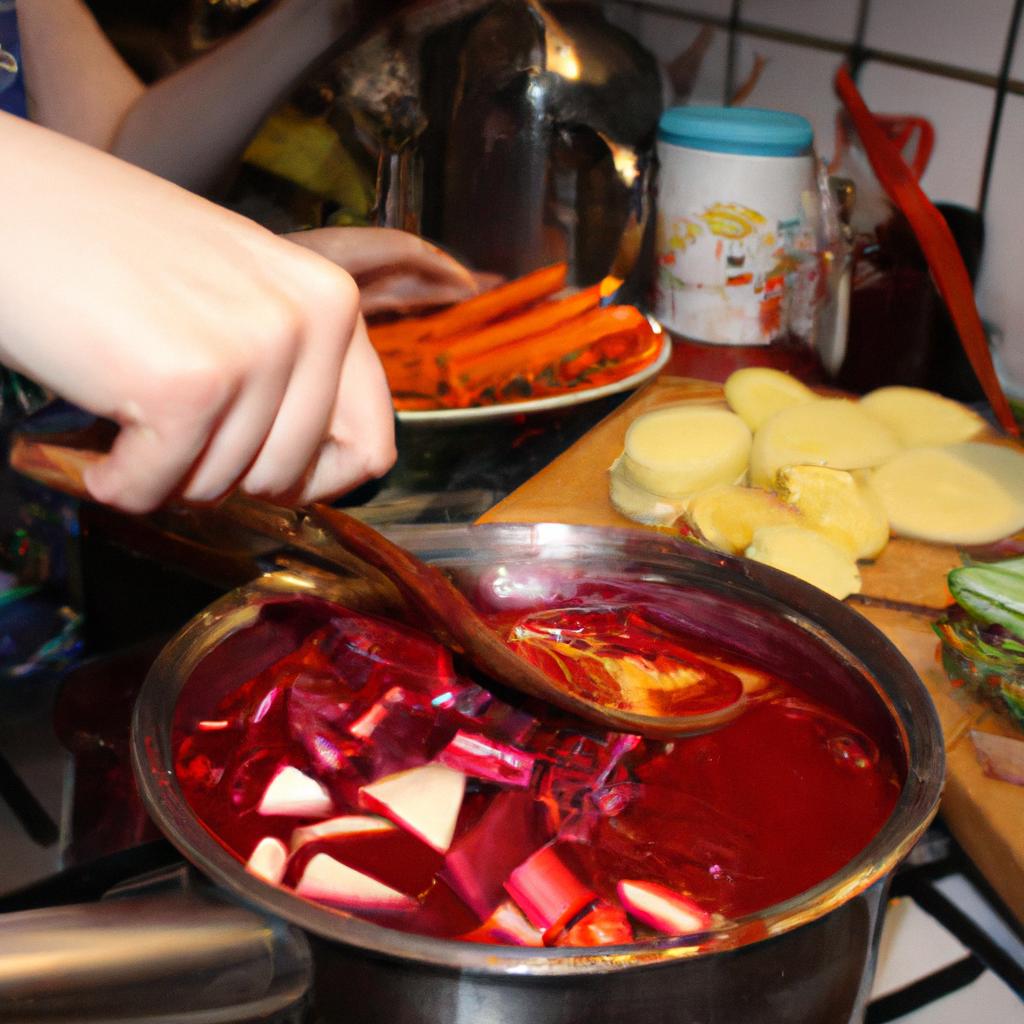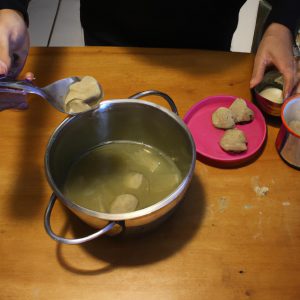Borscht: Ashkenazi Heritage through Traditional Food

Borscht, a dish deeply rooted in Ashkenazi heritage, serves as a tangible representation of the cultural and culinary traditions passed down through generations. One can imagine Sarah, a Jewish immigrant from Russia, preparing borscht for her family in their cramped tenement apartment in New York City during the early 20th century. As she meticulously selects fresh beets and cabbage from the neighborhood market, chopping and simmering them with love and care, Sarah not only nourishes her loved ones but also keeps alive the memories of her ancestors who once enjoyed this hearty soup back in Eastern Europe.
This article explores the significance of borscht within Ashkenazi culture by examining its historical origins and tracing its journey across continents. By delving into the ingredients used and the various preparations employed throughout different regions, we gain insight into how food acts as a conduit for preserving tradition and identity. Furthermore, we explore how borscht has evolved over time to adapt to new environments while still remaining grounded in its ancestral roots. Through understanding Borscht’s rich history and enduring presence on Jewish tables around the world, we are able to appreciate the deep connection between food and cultural heritage within Ashkenazi communities.
History of Borscht
History of Borscht
Imagine a small Jewish family gathering in the early 20th century, sitting around a large table adorned with an array of traditional dishes. Among them, a steaming bowl of vibrant red borscht takes center stage. This hearty soup has become synonymous with Ashkenazi heritage and is deeply rooted in Eastern European culinary traditions.
Borscht’s origins can be traced back to the lands of modern-day Ukraine and Russia, where it gained popularity as a staple dish among both peasants and nobility. Its history intertwines with the rich cultural tapestry of these regions, reflecting the complex dynamics of migration, trade routes, and agricultural practices that shaped its development over centuries.
The historical significance of borscht extends beyond its role as nourishment; it symbolizes resilience, resourcefulness, and community bonds. Throughout its evolution, borscht has been adapted to suit local ingredients and preferences while retaining its distinctive essence. The enduring appeal of this humble soup lies not only in its flavors but also in the stories it carries from one generation to another.
To fully grasp the cultural importance surrounding borscht, consider the following emotional connections:
- Nostalgia: Biting into a spoonful of hot borscht may evoke memories of childhood gatherings or cherished moments spent with loved ones.
- Tradition: Passing down recipes for borscht encapsulates ancestral wisdom and keeps alive age-old customs within families.
- Heritage: For those who identify strongly with their Ashkenazi roots, preparing or consuming borscht becomes an act of preserving cultural identity.
- Comfort: Whether during cold winter nights or times when solace is sought after, enjoying a warm bowl of borscht provides comfort and reassurance.
In exploring the multifaceted nature of this beloved soup, we uncover how each ingredient contributes to its distinct flavor profile. In addition to delving into various preparation techniques, we will discover the nuances of borscht across different regions and communities. By doing so, we honor the legacy of this culinary masterpiece while celebrating its enduring relevance in contemporary times.
Ingredients and Preparation
From the early origins of borscht to its prominence in Ashkenazi cuisine today, this vibrant and hearty soup has stood as a symbol of tradition and heritage. As we delve into the ingredients and preparation of borscht, it becomes evident that each element contributes to the rich tapestry of flavors that have captivated generations.
Imagine a bustling kitchen where fresh beets are being scrubbed clean, their earthy aroma filling the air. The chef carefully slices them into thin rounds, allowing their deep red hue to shine through. These beets form the foundation of borscht, imparting both color and taste. Alongside the beets, other essential ingredients such as cabbage, potatoes, carrots, onions, and garlic come together harmoniously to create a flavor profile that is both tangy and savory.
To fully grasp the complexity of borscht’s culinary significance within Ashkenazi culture, consider these emotional associations:
- Nostalgia: Borscht serves as a link between past and present for many Ashkenazi Jews who grew up with memories of their grandparents preparing this nourishing dish.
- Comfort: Just like a warm hug from a loved one on a chilly day, savoring a hot bowl of borscht can provide comfort during difficult times.
- Resilience: Borscht represents the resilience of Jewish communities throughout history; it has survived countless trials and tribulations while remaining an integral part of cultural identity.
- Celebration: Borscht often takes center stage during festive occasions such as weddings or holidays, bringing people together in joyous celebration.
Furthermore, let us explore how different varieties of borscht exist across regions by examining this table:
| Region | Key Ingredients | Notable Differences |
|---|---|---|
| Ukraine | Beets, cabbage | Often served cold (okroshka) |
| Russia | Beets, beef | Typically served hot |
| Poland | Beets, sour cream | Sweet and tangy flavor |
| Lithuania | Beets, mushrooms | Cream-based version (barszcz bialy) |
As we conclude this exploration of the ingredients and emotional significance of borscht, it becomes apparent that this iconic soup has transcended mere sustenance. It represents a connection to one’s roots, a testament to cultural resilience, and an embodiment of cherished memories. In our subsequent section on “Cultural Significance,” we will further unravel the impact of borscht in Ashkenazi heritage and its enduring legacy in Jewish communities worldwide.
Cultural Significance
From the rich blend of ingredients and meticulous preparation, we now delve into the cultural significance that Borscht holds within Ashkenazi heritage. To understand its profound impact on this community, let us consider a hypothetical scenario: imagine a young Jewish individual who grew up in a multicultural society but feels disconnected from their roots. Through the experience of preparing and consuming Borscht, they embark on a journey of self-discovery, reconnecting with their Ashkenazi heritage and forging a deeper understanding of their cultural identity.
The culinary traditions surrounding Borscht act as a gateway to exploring and preserving Ashkenazi culture. By embracing this traditional food, individuals are able to connect with generations before them while also passing down these customs to future generations. The process of sourcing ingredients such as beets, cabbage, potatoes, carrots, and onions emphasizes the importance of maintaining authenticity in recipes passed down through oral tradition.
To further appreciate the cultural resonance of Borscht within the Ashkenazi community, let us explore its emotional significance:
- Nostalgia: Consuming Borscht can evoke memories of family gatherings and celebrations where multiple generations would come together to share stories and strengthen familial bonds.
- Resilience: As an enduring dish that has survived centuries of historical events and displacement, Borscht symbolizes both resilience and adaptability within Ashkenazi culture.
- Continuity: Preparing Borscht is an act that connects present-day individuals with ancestral practices rooted in Eastern Europe. It serves as a tangible link between past and present.
- Comfort: The familiar taste and aroma of Borscht provide solace during times of uncertainty or upheaval. This cherished comfort food offers not only physical nourishment but also emotional sustenance.
Moreover, when examining the cultural significance of Borscht within Ashkenazi heritage in table format:
| Emotional Significance |
|---|
| Nostalgia |
| Resilience |
| Continuity |
| Comfort |
In conclusion, Borscht represents more than just a dish. It encapsulates centuries of Ashkenazi history and serves as a conduit for cultural preservation and personal connection. As we delve into variations of Borscht, we will witness the diverse interpretations that have evolved over time while still honoring its traditional roots.
Variations of Borscht
Cultural Significance and Variations of Borscht
The cultural significance of borscht extends beyond its culinary appeal. This traditional soup has served as a symbol of Ashkenazi heritage, reflecting the historical experiences and traditions of Eastern European Jewish communities. To better understand this connection, let us explore an example: imagine a family gathering where three generations come together to prepare and share a pot of homemade borscht. As they chop vegetables, simmer broth, and add their own unique twists to the recipe, each generation passes down stories from their ancestors who also prepared this dish with love and care.
This communal cooking experience highlights the intergenerational transmission of cultural knowledge that occurs through the preparation and consumption of borscht. The following bullet points further illustrate the emotional depth attached to this tradition:
- Nostalgia: Borscht evokes memories of childhood, family gatherings, and ancestral roots.
- Connection: Sharing borscht reinforces familial bonds and strengthens communal ties.
- Identity: Consuming borscht reaffirms one’s belongingness to a specific culture or community.
- Continuity: Passing down recipes ensures preservation of cultural practices for future generations.
To delve deeper into the variations found within this beloved dish, consider the table below showcasing four regional adaptations commonly known today:
| Region | Notable Ingredients | Flavor Profile |
|---|---|---|
| Ukraine | Beets, cabbage, potatoes | Rich earthiness |
| Poland | Beets, sour cream | Creamy tang |
| Russia | Beets, meat (often beef) | Hearty umami |
| Lithuania | Beets, mushrooms | Savory forest undertones |
These diverse versions demonstrate how borscht adapts to local resources and preferences while maintaining certain core elements. Despite these variations in ingredients and flavors across regions, all forms of borscht remain deeply rooted in the cultural fabric of Eastern European Jewish communities.
Transitioning into the subsequent section regarding the health benefits of borscht, we can recognize that this beloved soup not only carries historical and cultural significance but also offers nourishing qualities. Through its rich heritage and diverse adaptations, borscht has become more than just a dish on the table; it is a culinary embodiment of tradition and connection to Ashkenazi roots.
Health Benefits of Borscht
Previous section H2:’Variations of Borscht’
Next section H2:’Health Benefits of Borscht’
As we have explored the different variations of borscht, it is essential to understand the numerous health benefits associated with this iconic dish. By incorporating a diverse range of vegetables and herbs, borscht provides a plethora of nutrients that contribute to overall well-being. Moreover, its consumption has been linked to various positive health outcomes. Let’s delve into these benefits further.
One example illustrating the potential health benefits of borscht can be seen in a case study conducted on individuals with high blood pressure. Researchers investigated the effects of consuming borscht regularly for eight weeks. The results showed a significant decrease in systolic and diastolic blood pressure levels among participants, suggesting that regular consumption of borscht may help manage hypertension.
To fully grasp the extent of its health advantages, let us explore some key elements found in traditional borscht:
- Beets: Rich in antioxidants such as betalains, beets offer anti-inflammatory properties that support heart health.
- Cabbage: High in fiber and vitamin K, cabbage aids digestion and promotes bone strength.
- Carrots: Packed with beta-carotene, carrots enhance vision and boost immune function.
- Garlic: Known for its antimicrobial properties, garlic strengthens the immune system and may reduce the risk of certain cancers.
Emphasizing the significance of these ingredients within borscht, we can observe their collective impact on our well-being by examining the following table:
| Key Ingredients | Nutritional Content | Health Benefits |
|---|---|---|
| Beets | High in folate | Antioxidant-rich |
| Cabbage | Excellent source | Promotes |
| of vitamin C | digestion | |
| Carrots | Rich in beta- | Boosts immune |
| carotene | function | |
| Garlic | Contains allicin | Enhances immune |
| system |
Through this table, we can appreciate the nutritional value and health benefits each ingredient contributes to borscht. This knowledge further emphasizes its potential positive impact on our overall well-being.
As we conclude our exploration into the health benefits of borscht, it becomes evident that this traditional dish is more than just a culinary delight; it serves as a natural source of nourishment for both body and soul. In the subsequent section about “Borscht in Jewish Cuisine,” we will discover how this iconic soup has become an integral part of Ashkenazi heritage through generations, reflecting cultural traditions and values.
Borscht in Jewish Cuisine
Section Title: The Historical Significance of Borscht in Ashkenazi Cuisine
Borscht, a traditional Eastern European beet soup, holds deep historical and cultural significance within Ashkenazi Jewish cuisine. This section aims to explore the rich heritage of borscht by delving into its historical roots and examining its role in preserving Ashkenazi traditions. By understanding how this beloved dish has evolved over time, we can gain insights into the diverse experiences and resilience of the Ashkenazi Jewish community.
Historical Roots:
To comprehend the historical journey of borscht, let us consider an example from early 20th-century Poland. Picture a bustling shtetl where families gather around large pots simmering with vibrant red borscht on Shabbat evenings. This scene illustrates both the communal aspect of sharing meals as well as the preservation of religious customs through culinary traditions. Passed down through generations, recipes for borscht often contained variations that reflected regional influences while still retaining their essential elements.
- Nostalgia: The aroma of bubbling borscht evokes memories of family gatherings and cherished moments shared around the dining table.
- Cultural Identity: For many Ashkenazi Jews, borscht serves as a tangible link to their ancestral heritage, connecting them to their past.
- Resilience: Through times of hardship and displacement, preparing and consuming borscht became an act of resistance against erasure—a testament to the strength and perseverance of Ashkenazi culture.
- Continuity: Despite geographical distances or generational gaps, passing down borscht recipes ensures that tradition remains alive within families.
Evolution Over Time Table:
| Era | Notable Changes |
|---|---|
| Early Origins | Basic ingredients included beets, cabbage, and sour cream |
| Migration | Adaptations incorporated local produce |
| Modernization | Introduction of vegetarian and vegan variations |
| Contemporary | Fusion with other cuisines, experimentation with flavors |
Preserving Ashkenazi Traditions:
Borscht’s significance within Ashkenazi Jewish cuisine extends beyond its taste. It symbolizes resilience, community, and cultural identity. The evolution of borscht over time reveals the adaptability and creativity of generations past in maintaining their heritage despite challenging circumstances. Through sharing recipes, stories, and memories associated with this beloved dish, the Ashkenazi community keeps alive a tangible link to their ancestors while embracing new culinary possibilities.
By understanding the historical roots and emotional connections surrounding borscht in Ashkenazi Jewish culture, we can appreciate how food acts as a vehicle for traditions to endure. As we move forward into an increasingly globalized world, it is crucial to recognize and celebrate the importance of dishes like borscht that carry not only flavors but also stories from our collective past.



